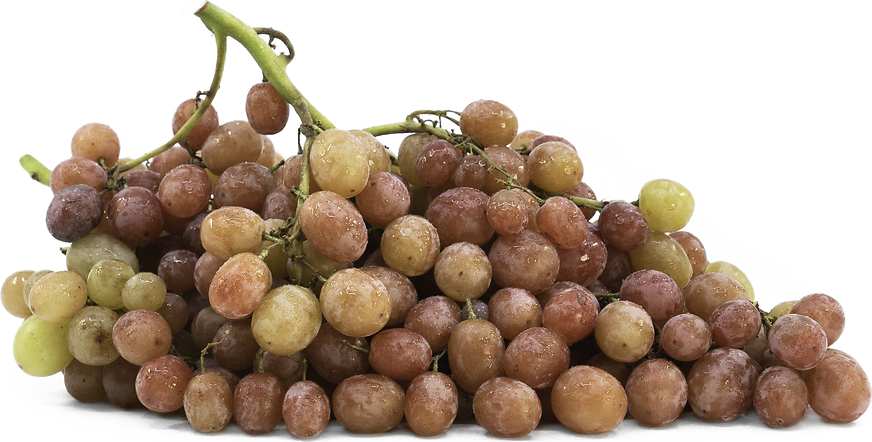


Sweet Scarlett Grapes
Estimated Inventory, lb : 0
Description/Taste
Sweet Scarlet grapes are small to medium in size and are round to oval in shape, growing in large, dense, conical-shaped clusters. The semi-thick skin is smooth, firm, and is known for its deep raspberry coloring which is brighter than other red table grapes. The flesh is a pale, translucent green, juicy, and seedless, though there may be some small undeveloped seeds present that are undetectable when consumed. Sweet Scarlet grapes are crisp and tender with a sweet and light muscat flavor.
Seasons/Availability
Sweet Scarlet grapes are available late summer through early fall.
Current Facts
Sweet Scarlet grapes, botanically classified as Vitis vinifera ‘Sweet Scarlet,’ is considered a mid-season ripening cultivar. It is a relatively new seedless red table grape that boasts an intricate parentage consisting of divizich early, italia, calmeria, muscat amburg, perlette, flame seedless, muscat of alexandria, agadia, blackrose, maraville, tafafihi ahmur, autumn seedless, sultanina, and fresno seedless. Sweet Scarlet grapes were developed by the Agricultural Research Service (ARS) in central California to create seedless table grapes with more unique flavors.
Nutritional Value
Sweet Scarlet grapes contain vitamins C, B6, and K, antioxidants, and the polyphenol, resveratrol, which is found in the skin of the grape and acts similarly to antioxidants to protect the body from cell damage and to help promote heart health.
Applications
Sweet Scarlet grapes are best suited for raw preparations and are most commonly consumed fresh, out-of-hand. The grape’s subtle muscat flavor pairs well on charcuterie and cheese boards, and can be used in desserts such as cakes, tarts, and sorbets. Sweet Scarlet grapes can also be lightly cooked and served atop roasted chicken, couscous, or with Brussel sprouts. They can be sliced fresh and added to fruit or green salads or frozen and used as natural ice cubes to chill white wine and rosé without watering down the beverage. Sweet Scarlet grapes pair well with prosciutto, salami, duck, chicken, pork, nuts, blue cheese, gouda, brie, swiss, and goat cheese. They will keep up to two weeks when stored unwashed in a perforated bag in the refrigerator.
Ethnic/Cultural Info
The Sweet Scarlet grape was originally a patent protected variety in 2003, and all distribution was regulated by the California Table Grape Commission. The Sweet Scarlet was one of many grapes patented at the time, but in 2012 growers filed lawsuits against the California Table Grape Commission and the United States Agriculture Department (USDA) over the patents. The Supreme Court ruled in favor of the growers which lifted the veil of protection that had been shielding the USDA from lawsuits such as this in the past. It also gave power back to the growers so varietals such as Sweet Scarlet would now have the chance to be grown by more than just a select few without having to pay exorbitant fees.
Geography/History
Sweet Scarlet grapes were developed by horticulturist David Ramming and technician Ron Tarailo of the United States Department of Agriculture’s Agricultural Research Service (USDA-ARS) in central California. Ramming and Tarailo created a cross of 2 USDA-ARS variety grapes, C33-30 X C103-41, and after over a decade of breeding, testing, and growing the grape, it was ready and given the name, Sweet Scarlet. It was patented in 2003, released in 2004 to a limited amount of select growers, and by 2010 the patent had been lifted, and the Sweet Scarlet was made public making it available to all who wanted to grow it. Today Sweet Scarlet grapes are grown predominately in California and can be found at specialty markets across the United States.




